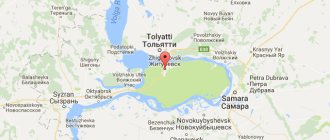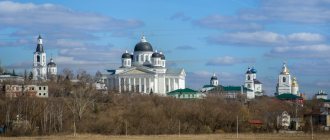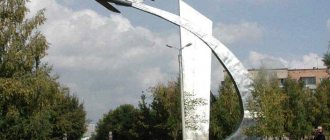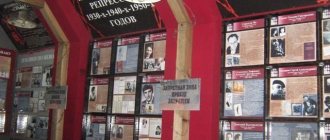Volzhsk is a large city in the Mari El Republic. Yandex maps of Volzhsk show that the city is located on the coast of the famous Volga River.
The city was created as an industrial settlement.
One of the first enterprises in the city was a pulp and paper mill.
The city is an administrative center and also has great engineering potential.
Using a satellite map of Volzhsk, you can see that the city borders on the republics of Tatarstan and Chuvashia.
The capital of the region is located 100 km from Volzhsk.
The city has favorable transport links. Significant highways pass through its territory. There is also a railway line leading into the city.
Map of Volzhsk with streets
There are two marinas within the city of Volzhsk. Industrial ships approach the Zarya pier, and the Mayak pier serves passenger routes.
Using a map of Volzhsk you can find the city's bus stations by district. One of them carries passengers, and the second only carries cargo flights.
There is a railway station within the city. You can get around the city using buses and minibuses. In total, there are 8 routes in Volzhsk.
Geographically, the city is divided into 11 residential areas. It also includes two industrial areas. The city also owns the following villages: Kulatsky, Russkaya Lugovaya and Ariada. A map of Volzhsk will help you find them.
Volzhsk is the second largest city in the Republic of Mari El, the center of the Volzhsky district, which it is not part of, forms a separate urban district “City of Volzhsk”. Located on the left bank of the Volga (Kuibyshev Reservoir), at the extreme southern point of the republic, 101 km south of its capital Yoshkar-Ola and 49 km from Kazan. In the south it borders with Chuvashia, in the east with Tatarstan.
There is communication with neighboring cities and regions via several transport routes: the Kazan - Yoshkar-Ola highway, a section of the highway through the Cheboksary hydroelectric power station (between Kazan and Cheboksary), the railway line of the Gorky railway Kazan - Zeleny Dol - Yoshkar-Ola. A separate direction is shipping on the Volga River. On the banks of the Volga there are two piers (“Zarya” is a pier only for industrial ships).
Distance from Volzhsk to the nearest cities and regional centers by road: Zelenodolsk - 10 km, Innopolis - 28 km, Kazan - 49 km, Novocheboksarsk - 60 km, Kanash - 71 km, Cheboksary - 75 km, Yoshkar-Ola - 97 km, Kozmodemyansk - 140 km, Ulyanovsk - 171 km, Chistopol - 180 km, Mamadysh - 206 km, Nurlat - 222 km, Saransk - 278 km, Almetyevsk - 280 km, Naberezhnye Chelny - 300 km, Syzran - 302 km, Izhevsk - 318 km, Samara - 324 km, Nizhny Novgorod - 355 km, Glazov - 361 km, Kirov - 430 km, Balakovo - 431 km, Ufa 498 km, Syktyvkar - 790 km, Moscow - 792 km.
Working village Lopatino, st. Shchorsa (now Lenin Street). Photo 1936
The city arose on the left bank of the Volga River on the site of the ancient Russian village of Lopatino, the founders of which are mentioned in historical sources of the 16th-17th centuries. The area was called Lopatinsky backwater or Lopatinskaya Volozhka. Here, wood was harvested and processed at the sawmills of the merchants Gubin and Shishokin. The name “Lopatino” is explained in different ways: according to one version, it is associated with the name of the merchant Yegor Lopatin, who owned one of the sawmills, according to another, with a working tool, a shovel, which was used to extract alumina.
The building of the local history museum, archival photo
In 1929, clearing of the area began in Lopatino for the construction of a four-frame sawmill, which was one of the impact facilities of all-Union importance. In 1930, one-story barracks, a bakery and a large canteen (also served as a meeting place) were built for the plant workers. Since that time, Lopatino has been called a workers' village.
In 1930, closer to the village of Polki, factory dormitories were built according to the “house-commune” project - with common corridors, kitchens and dining rooms (that’s why the village was called Commune). A little later, a “technical village” for engineering and technical workers and construction management employees appeared to the southwest of the plant.
Lopatino, archival photo
The main thing for the further development of the village was the construction of a sulphate-pulp-paper mill (Marbumkombinat), an enterprise of national importance, with the advent of which they hoped to solve the problem of the shortage in the USSR of certain technical types of paper purchased abroad. In 1931, a decree “On Lopatin Construction” was issued. Teams of qualified carpenters, masons, stove makers and reinforcement workers were sent here. The first production of the woodworking plant was a sawmill. Simultaneously with the construction of the plant, a hospital building and other infrastructure facilities were erected.
Construction of the Mari Pulp and Paper Mill. Archive photo
In 1933, by a resolution of the RSFSR PVS, the settlement at the Lopatinsky building parts plant was classified as a workers' settlement, including the village of Polka. The same decree gave the name Lopatino to the village. In 1933, 682 people lived in the village. There was a post office, a club, a school, a radio center, a first-aid post, a store and a bathhouse here.
In 1934, the construction of the railway line from Lopatino to Zeleny Dol station was completed and a motor locomotive was launched. By 1937, 10,321 people already lived in the village, in 1938 - 15,675. By Decree of the Presidium of the Supreme Soviet of the RSFSR, on August 26, 1939, the Lopatinsky Village Council and adjacent territories were allocated to a new district, called Volzhsky. The center of the district became the working village of Lopatino.
Soon the question of organizing a regional newspaper arose. By that time, the newspaper “Bumstroevets” was already published in Lopatino. The Bureau of the Regional Committee of the All-Union Communist Party of Bolsheviks adopted a resolution on the publication of the Volzhskaya regional newspaper with a circulation of three thousand copies. N.I. Speransky was appointed editor of the newspaper; the first issue of the newspaper was published on November 7, 1939.
The construction of the plant became a city-forming factor for the settlement - housing construction began to develop. Subsequently, the need arose for the construction of public utilities, kindergartens and schools. In 1939, the regional center of Lopatino had 16,449 residents, of which 9,824 were over 18 years old. In the same year, the number of enterprises in the village was: Marbumkombinat - 1590 people, woodworking plant - 940 people, timber - 135 people, Marbumstroy Kirzavod - 145 people.
Volzhsk, palace of culture of the MTPM plant, photos from different years
By 1940, in the regional center of Lopatino there was an extensive network of social, cultural and educational institutions. This is evidenced by the presence in Lopatino of a water supply system, a power station, a radio center, a telegraph, two telephone exchanges, two branches of a savings bank, a laundry, workers' clubs, a pioneer club, and libraries. 1074 residential buildings were built in the village and 11 shops were opened.
The social sphere of the Lopatino regional center in terms of the volume of services corresponded to the urban structure, so the Lopatinsky village had all the conditions for further growth and development. On July 6, 1940, by the Decree of the Presidium of the Supreme Soviet of the RSFSR, the workers' village of Lopatino was transformed into the city of Volzhsk, which was named after its location on the banks of the Volga.
The plant buildings come close to the shoreline
The impetus for the further development of Volzhsk was the construction in the 1960-1970s. hydrolysis-yeast and electromechanical plants. In 1987, the joint Soviet-Italian production of refrigeration equipment Sovitalprodmash opened in the city. With the emergence of new enterprises, new residential microdistricts appeared - “Druzhba”, “Mashinostroitel”, “VDK” and “Severny”.
Volzhsk, cinema "Rodina"
Volzhsk has close ties with Zelenodolsk, located 12 km east, and also gravitates towards the Kazan agglomeration, despite the fact that they are located in another republic - Tatarstan. This became especially noticeable in the 1990s, when the economic crisis hit the city’s economy hard.
Social problems worsened, debts to pay for utility services amounted to colossal amounts, and interruptions in the supply of heat and water began. The mayor of Volzhsk was arrested. At the end of the 1990s. Unrest began in Volzhsk. The townspeople initiated a petition to transfer the city under the jurisdiction of the economically more prosperous Tatarstan. The initiative was not supported by the authorities and the transition did not take place. Debts on utility payments were assumed by the Republic of Mari El. However, the subsequent socio-economic situation in Volzhsk is connected with integration ties with neighboring Zelenodolsk.
In 2016, it was announced that railway traffic throughout the Mari El Republic was canceled, including the Kazan-Volzhsk electric train, which ran to the station for six months. Paratsk (Zelenodolsk). In 2022, two pairs of trains were again extended to the station. Volzhsk due to technological necessity (lack of overnight parking tracks for electric trains at the neighboring stations Zelenodolsk and Paratsk). In 2022, the Marbumkombinat platform was reconstructed.
In the 2000s. In Volzhsk, construction was resumed, housing and communal services were established. The improvement of central streets is underway, residential construction has been resumed, the resettlement of emergency and dilapidated housing, and the construction of sports facilities have been resumed.
The main streets of Volzhsk are Lenin, Gagarin, Shestakov, Prokhorov, 107th Brigade and Koshkin. There are squares - Sovetskaya, Pobedy, the 170th anniversary of the death of A.S. Pushkin, Good and Peace named after. Vasilyeva
As of January 1, 2022, in terms of population, the city was in 307th place out of 1,115 cities in the Russian Federation. According to census data, representatives of more than 55 nationalities live in the city. Russians predominate, then Mari, Tatars, Chuvash, Ukrainians, Mordovians and others. There are nine residential districts in the city: Vostochny, Mashinostroitel, Druzhba, VDK, Severny, Gorgaz, Zapadny (Lugovaya), Mamasevo, as well as two industrial districts — “Coastal” and “Promuzel”. In addition, the city includes the so-called Kulatsky village, the village of JSC Ariada and the village of Russkaya Lugovaya. The borders of Volzhsk today come close to the new Yoshkar-Ola - Kazan bypass highway.
Higher education in the city can be obtained at the Volga branch of the Volga State Technological University (formerly MCBT). Vocational education in Volzhsk is provided by the Construction and Industrial College (GOU SPO SPK, former vocational lyceum No. 4, State Pedagogical Technical University No. 4) and the Volzhsky Industrial College. The Volzhsky branch of the Yoshkar-Ola Medical School operates here.
Cultural educational institutions are represented by the Volga Children's Ecological Center, a music school (DMS), and three art schools (DCS). The choreographic ensemble “School of Dance” and the dance show group “Artes” at secondary school No. 9 named after A.S. are famous in the city. Pushkin and the children's and youth sports school of the Olympic reserve.
The urban outskirts of Volzhsk are built up with village-type houses
Among the memorable buildings of the city are the Rodina cinema, secondary school No. 3, the building of the canteen of the woodworking plant, the House of Culture of the Moscow Pulp and Paper Plant and the building of the former CPSU Civil Code. Residential areas of German buildings in the central part of the city are of certain historical and architectural interest. Some of the city's attractions include the Memorial to Fallen Warriors (Eternal Flame), the Memorial "Angel of Good and Peace" on the square named after. Vasiliev (laid in 2012 at the expense of the head of Ariada CJSC V.G. Vasiliev, including in memory of the events in Beslan), a monument to V.I. Lenin on Sovetskaya Square in front of the city administration building (reconstructed in 2015 by the Communist Party of the Russian Federation), the local history museum on Sovetskaya Square (formerly the CPSU Civil Code) and the “Heart of the City” square.
Among the religious buildings, St. Nicholas Cathedral, the Church named after. John of Kronstadt, the Church of All Who Sorrow Joy, the Church of the New Martyrs and Confessors of Russia and the cathedral mosque.
St. Nicholas Cathedral
In 1991-1993 in Volzhsk according to the design of the architect A.A. Veyukov built the St. Nicholas Cathedral. The compositional and architectural features of the building go back to the forms of church architecture of the 18th century. The bell tower, which has four tiers, is organically built into the refectory of the main part of the temple. Two fours carry two eights. On the ground floor of the cathedral there is a chapel in honor of St. Seraphim of Sarov.
Temple of the Icon of the Mother of God “Joy of All Who Sorrow”, Volzhsk
On the territory of the Volzhsk city hospital, with donations from citizens and enterprises in the 1990s. A temple was built, consecrated in the name of the icon of the Mother of God “Joy of All Who Sorrow.” In 1997, the main dome and cross were installed, and the lower aisle of the temple was consecrated in the name of the icon of the Mother of God “Seeking the Lost.” In 1999, the main altar of the temple was consecrated. A Sunday school building, a refectory and an almshouse were built on the territory of the temple. A children's ensemble and the Pushkin Society were created at the temple.
There are several large forest parks in the city. These are the Park of Culture and Recreation, Victory Park (old park), Druzhba Park, Mashinostroitel Park, Victory Square MTSBK and Oak Grove. In the vicinity of the city there are the Mari Chodra National Park (Maple Mountain, Green Spring, Pugachev Oak), dozens of lakes of karst origin (the most visited is Lake Yalchik) and numerous springs (the most famous in the village of Karay).
There are several cultural centers in Volzhsk - the City Culture Center, the MCBC Palace of Culture and the Zvezdny Central Cultural Center. There are three stadiums - city, Drevkombinat and Marbum Arena, more than forty gyms, several swimming pools and ski lodges. Media outlets include Volzhskie Vesti and the online publication Volzhsk 24.
Among the famous natives of Volzhsk are Andrei Vladimirovich Baranov, a Russian composer and virtuoso guitarist, Kamil Samigullin, the Supreme Mufti of the Republic of Tatarstan, and Ivan Valeev, a singer and musician.
Cathedral Mosque in Volzhsk
The city's production assets include more than thirty enterprises, of which 17 are large and medium-sized, and 14 are small enterprises. In total, about a hundred large and small enterprises are based in the city. They are located on the industrial sites of the city - the Pribrezhny districts (occupies the Volga coast within the microdistrict (remote from urban development, borders the Mamasevo microdistrict).
The most significant are still the Mari Pulp and Paper Mill (Marbumkombinat) and the Volzhsky Hydrolysis Yeast Plant. Medium-sized ones include MPDO Volzhsk (works with IKEA); JSC Polair-Nedvizhimost (formerly Sovitalprodmash Plant) is a manufacturer of professional refrigeration equipment; JSC "Ariada" - manufacturer of refrigeration equipment; JSC "Gran" is a developer and manufacturer of industrial quick-freezing, refrigeration and heat exchange equipment; Adzhio LLC is a large furniture company, one of the largest in Mari El; AS-M is one of the large furniture production facilities in the Volga Federal District; Volzhsky Plant of Construction Materials - production of cellular aerated concrete () - built from scratch in 2010; Fant Furniture is a large furniture company from the Republic of Tatarstan; Meat processing plant "Akashevsky". The share of paper production is approximately 29%, the share of mechanical engineering is 32%, the share of small and medium-sized businesses, the service sector, etc. is 39%.
Map of Volzhsk with houses
Volzhsk appeared relatively recently. But it has beautiful places that guests of the city will enjoy.
In the city you can see the following cultural and historical sites:
- The territory of Fontannaya Street is considered a wonderful place for walks in the fresh air. It has a beautiful fountain and memorial created in honor of the city's founders.
- St. Nicholas Cathedral is considered an important landmark of the city, which will help you find a map of Volzhsk with streets. The building was built in the 90s, but is designed in the old Russian style of the 18th century. An amazing element of the building is the bell tower, made in four tiers. The inside of the building is also beautiful. It was painted by famous local artists.
- There is another church in the city - the Church of the Icon of the Mother of God. The icon is kept in the temple and is considered healing.
- The city is famous for its natural attractions. One of them is the beautiful Sea Eye lake. It is located on a hill and is surrounded by pine and deciduous forests. The lake is considered very clean. The spring located nearby is also popular among tourists. Volzhsk routes on the map will lead to this place.
- Another notable natural site is Lake Yalchik. This is the largest body of water in the region and features magnificent scenery. The lake is located in the Mari Chodra park area.
- On Shchorsa Street there is a local history museum. It has departments dedicated to the history of the region and the city, as well as ethnography. The museum has halls where works of local craftsmen and artists are exhibited. On its territory are stored documents and photographs that capture the period of the revolution and the history of the formation of the city.
- A detailed map of Volzhsk will allow you to find the St. Guryev Church, which was built at the end of the 19th century. It is located not in the city itself, but in its surroundings. This place is known far and wide thanks to its healing springs. In addition, next to the temple there is a wooden cross that has miraculous powers.
- The oldest building in the city is the school, which was created more than a hundred years ago. It houses an art gallery.
Economics and transport
The basis of the city's economy is industry. The total number of different enterprises reaches 100 units. They are not related to the extraction of raw materials or their processing. The emphasis is on obtaining the final product. The most significant share is mechanical engineering. This is followed by paper production and other economic activities.
Transport is represented by buses and trains. A minibus taxi system has been developed, for which as many as 18 companies are responsible.
Volzhsk employment center vacancies
In the city (as of mid-2022) you can find a large number of vacancies. These are mainly engineering specialties, but there are other types of work. The salary picture is quite mixed and similar to the situation in most medium-sized cities in Russia. The minimum starts from 11,163 rubles per month. This salary level is relatively common. You can also often find vacancies with a salary of 15,000 rubles. Higher payments extend up to 35 thousand rubles, with the greatest frequency from 20 to 25 thousand rubles.
Thus, the population of Volzhsk has enough opportunities to get a job.
Population and economic situation
Like many other cities, Volzhsk went through the heyday of the Soviet period and the collapse of the 90s. The crisis of the 90s manifested itself especially acutely in this city. The situation was most critical in 1999. However, it was then brought under control and the socio-economic situation began to improve. The crisis of recent years has apparently bypassed this city. The reason could be the city development program adopted in 2015. Active construction of social and communal facilities is underway. Thus, the city has good prospects for improving its demographic indicators.
Population of Volzhsk
The number of residents of the city is relatively small, which is due to its small size. The population curve in Volzhsky has a semi-convex shape typical of many Russian cities. It grew until the mid-90s, and then gradually decreased. In recent years, this process has become barely noticeable, which indicates a gradual improvement in the demographic situation. In 1940, about 20,000 people lived in Volzhsk. At its peak in 1992, the population numbered 62,500 people. In 2017 it amounted to 54,500 people. According to this indicator, the city ranks 303rd in the list of cities in the Russian Federation.






